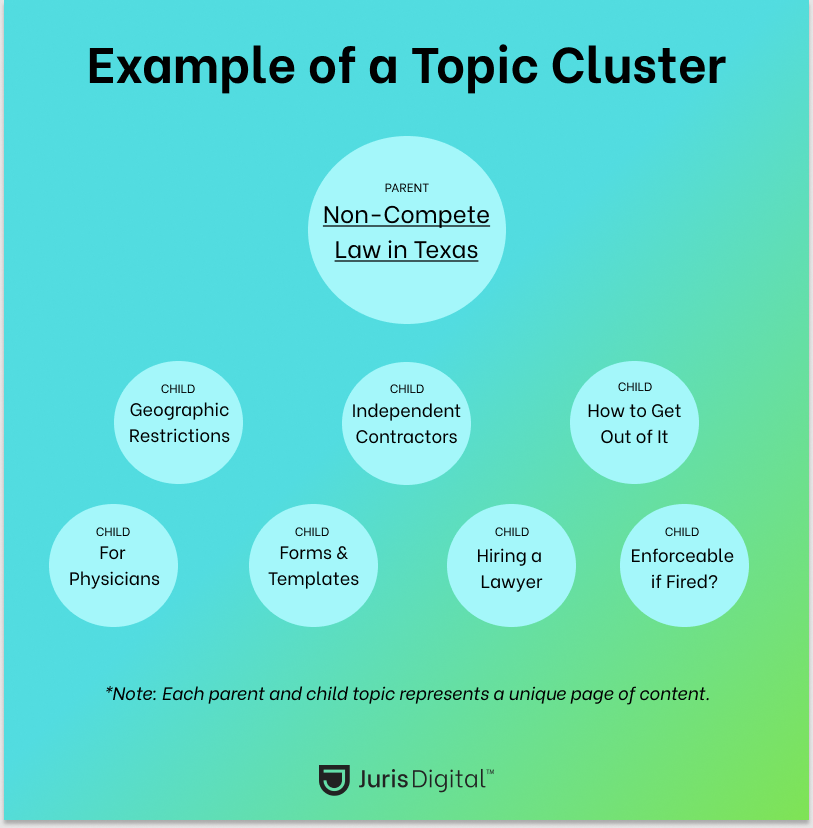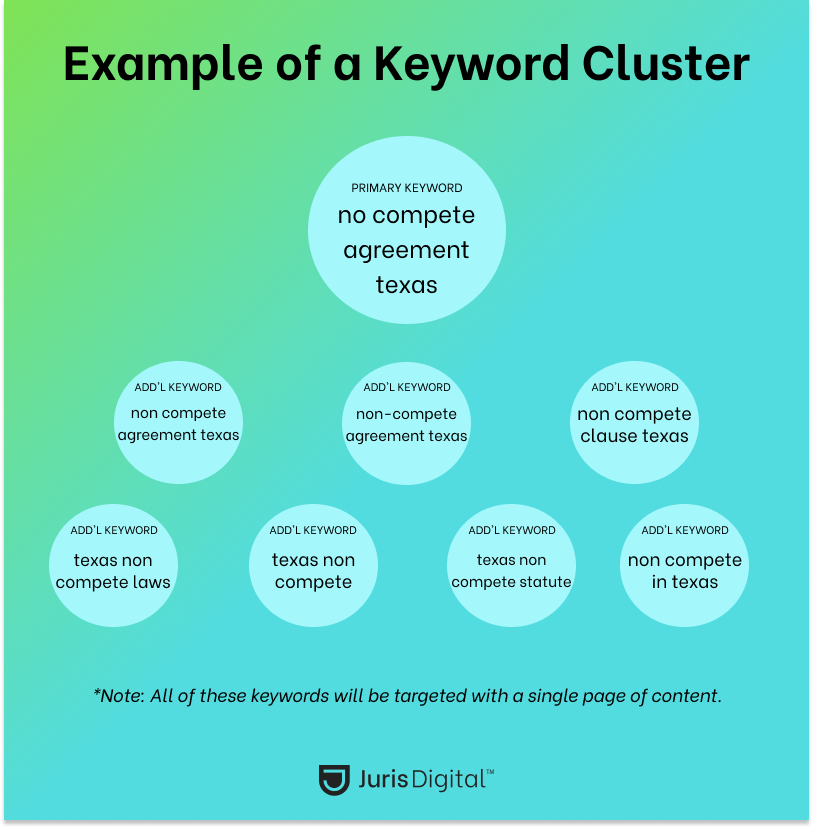In this post we’re going to look at two types of clusters – topics and keywords – and I am going to explain how you can leverage these concepts to drastically improve the efficacy of your law firm’s website content.
What Are Topic Clusters?
A topic cluster is a group of topics that relate to a parent topic. We generally talk about topic clusters in the context of a content strategy that is aimed at bringing in relevant search traffic. The output for this sort of strategy is usually a plan for the creation of group of pages (landing pages, blog posts, articles, etc.) around a specific topic.
Creating comprehensive topic clusters is essential for effective content marketing. Why? Because we know that Google cares about breadth of coverage when assessing a website. In other words, if you claim to be an authoritative source of information about non-compete agreements in Texas, Google wants to see that your website contains a wide breadth of coverage on this topic.
By intentionally creating topic clusters when crafting your law firm’s content strategy, you can deliver this breadth of coverage and give yourself the best possible chance at ranking highly for your target keywords.

What Are Keyword Clusters?
Whereas a topical cluster generally refers to a group of pages that you intend to create, a keyword cluster is a group of keywords (ie. search queries) that a single page is optimized to rank for.
A common mistake among less experienced SEOs and content marketers is assuming that – in order to rank for a variety of different keywords – one must create an equal number of different pages, with each page targeting just a single keyword.
However, in practice, a single page can rank for dozens, hundreds, or even thousands of individual keywords that people search to find basically the same information. The trick is to identify the cluster of keywords that you intend to optimize for with each individual topic that you create a page about.

Video: How to Create Effective Content Strategies Using Topic and Keyword Clusters
At Juris Digital we deploy these two concepts – topic clusters and keyword clusters – to maximize the efficacy of our client’s content marketing efforts. In the video below I demonstrate how we use topic and keyword clusters with a use-case from a real Juris Digital client.
Video Transcript
(00:02):
Hi everybody. My name is Matt Green and I’m the Chief Strategy Officer here at Juris Digital. And in this video, what I want to look at and kind of walk you through is a use case that demonstrates these concepts of a topic cluster and a keyword cluster, as they relate to legal content marketing and SEO for law firms. So let’s get into it.
(00:28):
If we back up a second, we’ll remember from the post that you’re reading currently that a topic cluster refers to, a group of sub topics that relate to a parent topic. So in practice, if one of our clients said to us, we want to bring in matters related to noncompete disputes, then we might create a topic cluster that looks like this. The parent topic is non-compete law in Texas. And then we have these child topics that relate to that parent.
(01:07):
So geographic restrictions of non-competes,independent contractors and non-compete agreements, how do I get out of a non-compete, non-compete for physicians, forms and templates related to non-competes.
(01:17):
So you can see where I’m going with this. It’s a group of child, topics that relate to a parent topic that creates a topic cluster. And in this case, every topic represents a unique page of content.
(01:40):
Then on the other side, we have a keyword cluster. A keyword cluster gets a little more granular and looks at a group of related keywords, that one single page of content can rank for. So, whereas the topic cluster, we’re talking about how a child topic relates to a parent topic…with a keyword cluster, what we’re looking at is a group of additional keywords that are very similar to a primary keyword. And then for that group, we can use one single page of content to target all of them.
(02:25):
Those are the basic concepts that you already know from, from reading the post. Here’s how we apply that in practice.
(02:30):
This is a client of ours, and on their site we created this parent topic of valuing injury claims. Because we know that when people are injured in an accident, a lot of the times what they’re searching online is “how much of a settlement can I expect” based on my specific type of injury or accident.
(02:58):
So in this case, look at the visual demonstration from the site map right here. We have this category that we created on valuing injury claims, and then we have all of the child topics here within that cluster, within that topical cluster. So we’ve got auto accident settlements, average wrongful death settlement, Walmart slip and falls settlements, herniated disc from a car accident, how big of a settlement can I get? So you can see all of these child topics related to the parent topic, and that is the visual kind of demonstration of our topic cluster. So that’s a topic cluster in practice in the real world.
(03:43):
And now what we can look at is a specific article that we published, based on one of our child topics. So Walmart slip and fall settlements. Now we start talking about and thinking about keyword clusters, right? What cluster of keywords is going to be relevant to this topic that we can use this one piece of content to rank for this whole cluster of keywords?
(04:11):
So, obviously if we look at our title tag up here, Walmart slip and fall settlements is what’s most, kind of prominent in there. So obviously that’s kind of going to be one of our primary keywords, but when we then go and examine this page in AHrefs, that’s where we can see again, a visual demonstration of a keyword cluster, right? So we have one piece of content on this parent topic of Walmart slip and fall settlements, and then we can see here a whole cluster of related very similar keywords that we’re ranking for all of them, and we’re bringing in traffic for all of them. So, we can expand this list. AHrefs is reporting that this is ranking for 170 keywords. Right here we have 20 and for some we’re [ranking] one. for some we’re three, some we’re six, but we’re ranking on the first page in a traffic generating position for all of these keywords.
(05:11):
This is this entire cluster of keywords. So this is just meant to demonstrate how you can start with your goals. So in the case of this example, the goal is bring in more traffic from people searching on valuing their settlement. So they’re searching, they’ve presumably been injured or in an accident and they’re searching on how do I value my settlement? What might it be worth? So the goal is bring in that type of traffic. The way we’re doing that is we’re creating a topical cluster around valuing injury claims with all of these child topics that relate to the parent topic of valuing injury claims. Then for each of those child topics, we’re creating a single piece of content that can rank for an entire cluster of keywords. So when we take this approach, we’re able to be strategic in that we’re targeting a specific audience, that, that we know is going to produce a good outcome.
(06:22):
We’re building out a breadth of coverage on that topic, right? So Google begins to see us as an authority on that parent topic of valuing injury claims. And then we’re also being strategic because for each child topic, we know that there’s a cluster of keywords that all get search volume, that all get traffic and that are related to our topic. So that with each piece of content, we’re not just ranking for one or two keywords, but we’re actually throwing our hat in the ring to rank for an entire cluster of related keywords that can bring in relevant traffic. Okay. I hope you found this useful, and if you did, or if you have questions, I hope you’ll leave a comment below. Thanks for watching.

